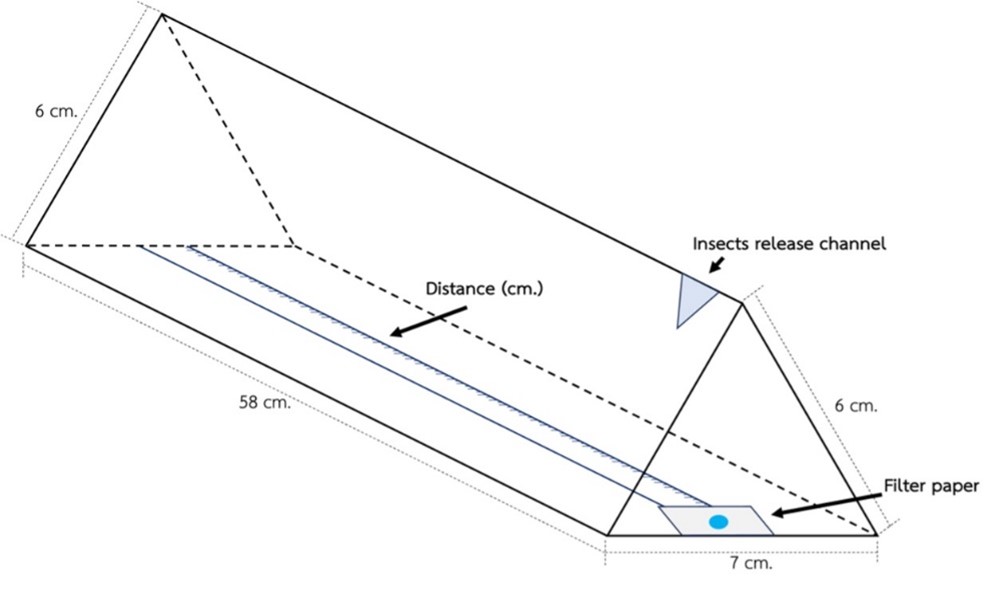ประสิทธิภาพของสารสกัดจากพืชต่อพฤติกรรมการถอยห่างของด้วงงวงข้าวโพด (Sitophilus zeamais Motschulsky)
Main Article Content
บทคัดย่อ
ด้วงงวงข้าวโพดเป็นแมลงศัตรูโรงเก็บที่สำคัญของเมล็ดข้าวและธัญพืช โดยมักสร้างความเสียหายโดยการกัดกินภายนอกเมล็ด ทำให้เกิดความเสียหายต่อปริมาณและคุณภาพเมล็ดได้ โดยการทดลองนี้มีวัตถุประสงค์เพื่อศึกษาพฤติกรรมของด้วงงวงข้าวโพดที่ตอบสนองต่อสารสกัดแต่ละชนิดด้วยวิธีการถอยห่างออกจากบริเวณที่มีสารสกัดจากพืช โดยสารสกัดจากพืชที่ใช้ทดสอบ ได้แก่ น้ำมันหอมระเหยส้ม น้ำมันหอมระเหย
ยูคาลิปตัส และสารสกัดต้นกล้าฟักทอง ความเข้มข้น 5% ต่อพฤติกรรมและระยะการถอยห่างจากสารสกัด
ของด้วงงวงข้าวโพดในอุโมงค์ทดสอบ ผลการทดลองพบว่า ด้วงงวงข้าวโพดตัวที่ตอบสนองไวที่สุด (n=5) ถอยห่างจากบริเวณวางสารสกัดแตกต่างกันในแต่ละกรรมวิธี โดยที่เวลา 1, 2, 3, 4 และ 5 นาที พบด้วงงวงข้าวโพดมีระยะถอยห่างจากจุดวางสารในชุดควบคุม เท่ากับ 19.00±9.02, 24.40±8.05, 30.20±7.25, 28.20±8.04 และ 27.40±10.59 ซม. ตามลำดับ ในขณะที่การใช้สารสกัดน้ำมันหอมระเหยส้มส่งผลให้ระยะการถอยห่างของด้วงงวงข้าวโพด เท่ากับ 34.40±3.36, 53.80±6.26, 56.80±2.68, 58.00±0.00 และ 58±00.00 ซม. ตามลำดับ สารสกัดน้ำมันหอมระเหยยูคาลิปตัสส่งผลให้ระยะการถอยห่างของด้วงงวงข้าวโพด เท่ากับ 31.00±10.46, 40.00±11.15, 50.20±12.43, 51.80±10.82 และ 53.80±9.39 ซม. ตามลำดับ และสารสกัดต้นกล้าฟักทองส่งผลให้ระยะการถอยห่างของด้วงงวงข้าวโพด เท่ากับ 24.20±10.42, 33.40±16.16, 32.20±9.70, 35.40±9.23 และ 40.60±11.84 ซม. ตามลำดับ นอกจากนี้ พบว่าสารสกัดน้ำมันหอมระเหยส้มมีด้วงงวงข้าวโพดถอยห่างไปถึงปลายอุโมงค์ทดสอบมากที่สุด (n=22)
Article Details

อนุญาตภายใต้เงื่อนไข Creative Commons Attribution-NonCommercial-NoDerivatives 4.0 International License.
Journal of TCI is licensed under a Creative Commons Attribution-NonCommercial-NoDerivatives 4.0 International (CC BY-NC-ND 4.0) licence, unless otherwise stated. Please read our Policies page for more information...
เอกสารอ้างอิง
จิรวัฒน์ เอี่ยมใจดี. (2559). การศึกษาพฤติกรรมด้วงงวงข้าวโพดที่ตอบสนองต่อสารสกัดจากพืช (วิทยานิพนธ์วิทยาศาสตรมหาบัณฑิต). ภาควิชากีฏวิทยา คณะเกษตร กำแพงแสน มหาวิทยาลัยเกษตรศาสตร์.
ชวลิต จิตนันท์. (2556). ความต้านทานต่อสารรมฟอสฟีนและประสิทธิภาพของฟีโรโมนที่มีต่อสายพันธุ์ต้านทานและสายพันธุ์อ่อนแอของมอดแป้ง Tribolium castaneum (Herbst) (Coleoptera: Tenebrionidae) (วิทยานิพนธ์วิทยาศาสตรมหาบัณฑิต). มหาวิทยาลัยเกษตรศาสตร์, กรุงเทพฯ.
นันทิยา จิตธรรมมา และศิริพรรณ ตันตาคม. (2549). ประสิทธิภาพในการเป็นสารฆ่าแมลงของน้ำมันหอมระเหยจากใบยูคาลิปตัส (Eucalyptus camaldulensis Dehnh) ต่อหนอนกระทู้ผัก (Spodoptera litura Fabricius) (วิทยานิพนธ์ปริญญาวิทยาศาสตร์มหาบัณฑิต). มหาวิทยาลัยเกษตรศาสตร์.กรุงเทพฯ.
ฤชุอร วรรณะ และรัชฎาพร วันชูเสริม. (2558). ประสิทธิภาพของน้ำมันหอมระเหยจากเปลือกของผลพืชวงศ์ส้มกำจัดด้วงงวงข้าว. วารสารวิทยาศาสตร์เกษตร, 46(3), 371-374.
วีระพล จันทร์สวรรค์ และ ณรงค์ จึงสมานญาติ. (2537). ศึกษาฤทธิ์ฆ่าเห็บโคของน้ำมันจากเปลือกผลส้ม. มหาวิทยาลัยเกษตรศาสตร์ สถาบันวิจัยและพัฒนา. กรุงเทพฯ.
เสาวลักษณ์ ไชยชมภู. (2547). การใช้คลื่นเสียงตรวจสอบการเจริญเติบโตการเข้าทำลายและพฤติกรรมของด้วงงวงข้าวโพด (วิทยานิพนธ์วิทยาศาสตรมหาบัณฑิต). มหาวิทยาลัยเชียงใหม่, เชียงใหม่.
Aref, S. P., & Valizadegan, O. (2015). Fumigant toxicity and repellent effect of three Iranian Eucalyptus species against the lesser grain beetle, Rhyzopertha dominica (F.) (Col.: Bostrichidae). Journal of Entomology and Zoology Studies, 3(2), 198-202.
Batish, R. D., Singh H. P., Kohli R. K., & Kaur, S. (2008). Eucalyptus essential oil as a natural pesticide. Forest Ecology and Management, 256, 2166-2174.
Choi, W. I., Lee, E. H., Choi, B. R., Park, H. M., & Ahn, Y. J. (2003). Toxicity of plant essential oils to Trialeurodes vaporariorum (Homoptera: Aleyrodidae). Journal of Economic Entomology, 96(5), 1479-1484.
Čmiková, N., Galovičová, L., Schwarzová, M., Vukic, M. D., Vukovic, N. L., Kowalczewski, P. L., Bakay, L., Kluz, M. I., Puchalski, C., & Kačániová, M. (2023). Chemical composition and biological activities of Eucalyptus globulus essential oil. Plants, 12(5), 1076.
Daglish, G. J., Nayak M. K., & Pavi, H. (2014) Phosphine resistance in Sitophilus oryzae (L.) from eastern Australia: Inheritance, fitness and prevalence. Journal of Stored Products Research, 59, 237-244.
Del Carmen Razola-Díaz, M., Guerra-Hernández, E. J., García-Villanova, B., & Verardo, V. (2021). Recent developments in extraction and encapsulation techniques of orange essential oil. Food Chemistry, 354, 129575.
Fouad, H. A., & da Camara, C. A. G. (2017). Chemical composition and bioactivity of peel oils from Citrus aurantiifolia and Citrus reticulata and enantiomers of their major constituent against Sitophilus zeamais (Coleoptera: Curculionidae). Journal of Stored Products, 73, 30-36.
Halaweish, F, T. & Tallamy, D. W. (1993). A new cucurbitacin profile for Cucurbita andreana: A candidate for cucurbitacin tissue culture. Journal of Chemical Ecology, 19(6), 1135-1141.
Isman, M. (1999). Pesticides based on plant essential oils. Pesticide Outlook, 10(2), 68-72.
Jarrahi, A., Saeid, M., & Sohrab, I. (2016). Chemical composition and fumigant toxicity of essential oil from Thymus daenensis against two stored product pests. Journal of Crop Protection, 5(2), 243-250.
Jesser, E. N., Werdin-Gonzáleza, J. O., Murray, A.P., & Ferrero, A. A. (2017). Efficacy of essential oils to control the Indian meal moth, Plodia interpunctella (Hübner) (Lepidoptera: Pyralidae). Journal of Asia-Pacific Entomology, 20, 1122-1129.
Karr, L. L., & Coats, J.R. (1988). Insecticidal properties of d-limonene. Journal of Pesticide Science, 13, 287-290.
Kim, S. -I., Yoon, J. -S., Jung, J. W., Hong, K. -B., Ahn, Y. -J., & Kwon H. W. (2010). Toxicity and repellency of origanum essential oil and its components against Tribolium castaneum (Coleoptera: Tenebrionidae) adults. Journal of Asia-Pacific Entomology, 13(4), 369-373.
Ngan, T. T. K., Nguyen, O. B., Muoi, N. V., Truc, T. T., & My, V. T. N. (2020). Chemical composition and antibacterial activity of orange (Citrus sinensis) essential oils obtained by hydrodistillation and solvent free microwave extraction. In IOP Conference Series: Materials Science and Engineering, 991(1), 12-23.
Ryan, M. F., & Byrne, O. (1988). Plant-insect coevolution and inhibition of cetylcholinesterase. Journal of Chemical Ecology, 14(10), 1965-1975.
Sarac, A., & Tunc, I. (1995). Toxicity of essential oil vapours to stored-product insect pests. Journal of Plant Diseases and Protection, 102(1), 69-74.
Sim, H. S., Jang, B. C., Park, H. M., Jeng, B. Y. & Oh, M. J. (2008). Isolation of cucurbitacin E from sprouted pumpkin seed and analysis of its anti-cancer and anti-inflammatory activities. Journal of the Korean Society of Food Science and Nutrition, 37, 834-840.
Sinthusiri, J. & Soonwera, M. (2014). Oviposition deterrent and ovicidal activities of seven herbal essential oils against female adults of housefly, Musca domestica L. Parasitology Research, 113, 3015-3022.
Tapondjou, A. L., Alder, C., Fontem, A. D., Bouda, H., & Reichmuth, C. (2005). Bioactivities of cymol and essential oils of Cupressus sempervirens and Eucalyptus saligna against Sitophilus zeamais Motschulsky and Tribolium confusum du Val. Journal of Stored Product Research, 41, 91-102.
Throne, J. E. (1994). Life history of immature S. zeamais (Coleoptera: Curculionidae) on corn stored at constant temperatures and relative humidity in the laboratory. Environmental Entomology, 23(6), 1459-1471.
Tofel, K. H., Kosma, P., Stähler, M., Adler, C., & Nukenine, E. N. (2017). Insecticidal products from Azadirachta indica and Plectranthus glandulosus growing in Cameroon for the protection of stored cowpea and maize against their major insect pests. Industrial Crops and Products, 110, 58-64.
Ukeh, D. A., Sylvia, B. A. U., Alan, S. B., Jennifer, M. L. A., John, A. P., & Michael, A. B. (2012). Alligator pepper, Aframomum melegueta, and ginger, Zingiber officinale, reduce stored maize infestation by the maize weevil, Sitophilus zeamais in traditional African granaries. Crop Protection, 32, 99-103.


